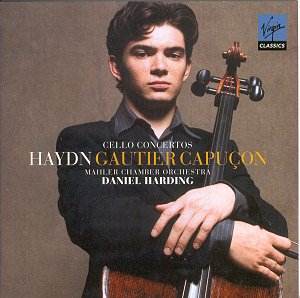Comparison Recording: Rostropovich/EMI
When I received this Virgin Classics disc for
review, I immediately opened the booklet to read about Gautier
Capuçon and the Mahler Chamber Orchestra. The effort was
not a fruitful one, as the booklet notes only go into detail about
the music. Fortunately, I was able to get some information courtesy
of the Internet. The Mahler Chamber Orchestra has its own website,
and the Virgin Classics website has a concise biography of Capuçon.
The Mahler Chamber Orchestra was founded in 1997
under the guidance of Claudio Abbado. The group has 49 members
covering 15 nationalities, and the average age is only 29. They
play in the neighborhood of 65 concerts a year, and the repertoire
extends from Baroque to new compositions. The Orchestra even performs
operas including Alban Bergís "Wozzeck". Daniel Harding
has been the principal guest conductor since 1998 and will assume
the role of music director this coming September.
Gautier Capuçon, born in 1981 in Chambéry,
is the younger brother of violinist Renaud Capuçon. Gautier
began playing the cello at the age of 5 and studied at the Conservatoire
National Supérieur Musique in Paris. He has won a number
of first prizes at cello competitions and performed with leading
conductors including Claudio Abbado, Bernard Haitink, Kent Nagano,
Pierre Boulez and Daniele Gatti.
In addition to being a concert soloist, Capuçon
is a member of a trio with his brother and the pianist Frank Braley;
they already have a Virgin Classics disc of Ravel chamber works
to their credit. Capuçonís usual instrument of choice is
a 1701 Matteo Goffriler cello and it sounds wonderful on this
Haydn disc.
For many years, my standard for Haydnís C major
and D major Concertos has been the EMI recording from Mstislav
Rostropovich with Iona Brown conducting the Academy of St. Martin-in-
the-Fields. These performances are treasured for their excitement
and emotional investment. Rostropovich makes the cello sing superbly
as he finds every kernel of meaning, while Brown always keeps
in step with Rostropovichís flair for dramatics and intensity.
Capuçon and Braley offer a different take
on the music. First, they are much leaner and convey more detail.
Although not lacking in excitement in the outer movements, their
performances do not attain the sheer weight of the Rostropovich.
So, there tends to be a trade-off of excitement for detail between
the two versions.
The slow middle movements also entail trade-offs;
the Rostropovich versions are slower and allow for much poignancy
and depth. As an example, Harding clocks in at only 6 Ĺ minutes
in the C major Adagio, while Brown extends the music to 8 Ĺ minutes.
Hardingís advantage is enhanced stature, while Capuçon
offers pungency that Rostropovichís modern cello canít possibly
match.
Speaking of Capuçonís period cello, it
is a glorious instrument of beauty and incisiveness. Given that
Capuçon at this stage of his career canít make a cello
sing as well as Rostropovich, I would give up a dayís income just
to hear Rostropovich play the 1701 Matteo Goffriler.
One additional consideration in deciding between
Rostropovich and Capuçon is the Benjamin Britten cadenza
used by Rostropovich in the C majorís 1st Movement.
This cadenza has a late romantic and even 20th century
sensibility, which is entirely absurd for a Haydn composition.
At best, it sounds silly Ė at worst, it is a pathetic appendage.
Capuconís liner notes do not specify the origin of his cadenza,
but it sounds similar to the idiomatic Heinrich Schiff cadenza
from his Philips recording.
The last cello concerto on the Capuçon
program is one of a few spurious concertos still carrying Haydnís
name. Although pleasant enough and certainly worthy of occasional
listening, the work doesnít display the variety of architecture
or inspiration of themes one would normally find in a Haydn composition.
Each of the three movements tends to get bogged down through repetition
and slack writing.
In conclusion, the Capuçon disc is a fine
alternative to the full-bodied Rostropovich performances. Both
Capuçon and Harding offer lean and incisive performances
of Haydnís vibrant concertos. With the added virtues of an exceptional
period cello and crisp soundstage, the disc is heartily recommended
to all Haydn and period instrument enthusiasts.
Don Satz
